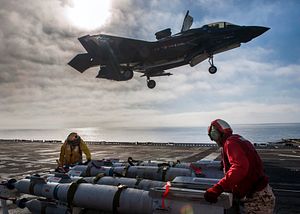The U.S. Navy has concluded a number of weapons load tests involving the supersonic fifth-generation F-35B Lightning II Joint Strike Fighter aboard the America-class amphibious assault ship, USS America, the lead vessel of her class, the U.S. Navy reports in a press release.
In detail, the weapons team aboard the USS America conducted ordnance separation tests and live-fire tests. According to the U.S. Navy, the weapons team tested all of the takeoff and landing worst-case scenarios. Pilots also performed test flights in bad weather conditions to test the F-35B’s limitations and capabilities when carrying heavy weapons payloads. The F35B is the U.S. Marine Corps variant, capable of vertical or short takeoffs and vertical landings without requiring a catapult launcher,
“The last couple of days we went and purposely found those nasty conditions and put the jets through those places, and the jet handled fantastically well,” said a Royal Air Force test pilot. “So now the external weapons testing should be able to give the fleet a clearance to carry weapons with the rough seas and rough conditions. We know the jet can handle it. A fleet clearance will come — then they can go forth and conduct battle in whatever environment.”
Munition tested included 72 laser-guided Guide Bomb Units (GBU)-12 Paveway IIs and 40 satellite-guided GBU-32s. The GBU 12 and GBU 32 are general purpose bombs weighting 510 pounds (230 kilograms) and 1,013 pounds (460 kilograms) respectively. According to the press release, “the test pilots from Marine Operational Test and Evaluation Squadron (VMX) 1 from Edwards Air Force Base, California, conducted successful live-weapons tests for two consecutive days by dropping six GBU-12s on a live-weapons range in Yuma, Arizona.”
The ground crew repeatedly tested building bombs. “The first thing we do is break out all of the equipment, starting with the bomb body, which contains the warhead,” he said. “We then attach the fins which help stabilize the aircraft, and attach the computer control group which guides the bomb. After the assembly is complete, we inspect the unit and all of the components,” according to a U.S. Navypetty officer aboard the USS America.
As I reported previously (See: ”US Navy Begins Testing of F-35B on Largest-Ever Amphibious Assault Ship”), a total of seven F-35Bs haven been conducting operational tests on the USS America beginning on October 28 and concluding on November 15. The USS America can accommodate up to nine F-35Bs, next to four AH-1Z Viper attack helicopters, four CH-53E Super Stallion helicopters, 12 MV-22 Ospreys, and two MH-60S Search and Rescue helicopters.

































